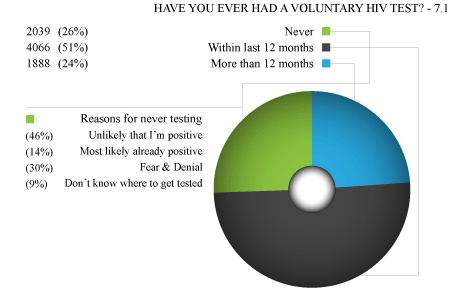 Finally! The organizers of the 2009 MSM Sex Survey that I blogged about back in March and posted a short update on in May have released the results. They initially said it would take about 60 days to release it but it took them 7 months! Well, I guess they had to really comb through the survey responses because they said just after the survey closed that they got more than 15,000 respondents for the survey but the final results only covered 7,993 people. That’s almost half the respondents that have been trimmed down! (Were there really that many bogus or unacceptable entries?)
Finally! The organizers of the 2009 MSM Sex Survey that I blogged about back in March and posted a short update on in May have released the results. They initially said it would take about 60 days to release it but it took them 7 months! Well, I guess they had to really comb through the survey responses because they said just after the survey closed that they got more than 15,000 respondents for the survey but the final results only covered 7,993 people. That’s almost half the respondents that have been trimmed down! (Were there really that many bogus or unacceptable entries?)
You can view the results on their website and you can download a PDF copy there if you want. Fridae.com, the main organizer, has posted highlights of the results in their news section. Shown below is an example data point from the results and below that are their conclusions from the survey.

- Not all MSM and TG are at equal risk for HIV infection. Men who abstain from sex, do not have anal sex, or use a condom consistently with all their sex partners when they have anal sex are at little to no risk of being infected with HIV.
- Those most at immediate risk are the 21% of men who have unprotected sex with casual partners (1664 of 7993) and 3% with commercial partners (253 of 7993).
- Unprotected anal sex amongst men in regular relationships is high (2455 of 3556 in a current relationship do not use condoms consistently). This is a cause for concern when either or both partners is also having unprotected anal sex with casual partners (816 of 3556). This puts not only themselves, but also their regular partners at risk.
- Recent HIV testing (within the last 12 months) was also low, and almost a quarter of those surveyed had never been tested. A significant number who have never been tested, or tested recently continue to have unprotected anal sex with casual partners (684 of 7993).
- The level of HIV acceptance in the community is relatively high, but despite this, the degree of HIV disclosure remains low.
While the results are interesting in itself, I wish they provided a breakdown of the results per country. Based on their demographics results, there were 252 non-rejected respondents from the Philippines. This is quite low but some data is better than none at all. Per-country breakdown is much more useful than aggregated data since prevention and mitigation of HIV and AIDS should be tailored to each country due to differing cultural norms, political systems, and infection rate. While the Philippines is still considered as a low-HIV-incidence country, recent alarming data from the Department of Health suggests that this might not be the case in a few years.
So what did you think of the results? Did you find anything particularly interesting?

0 comments:
Post a Comment